Consists of microtubules - Study guides, Class notes & Summaries
Looking for the best study guides, study notes and summaries about Consists of microtubules? On this page you'll find 705 study documents about Consists of microtubules.
Page 2 out of 705 results
Sort by
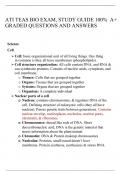
-
ATI TEAS BIO EXAM, STUDY GUIDE 100% A+ GRADED QUESTIONS AND ANSWERS
- Exam (elaborations) • 51 pages • 2024
-
- $9.49
- + learn more
Nuclear parts of a cell o Nucleus: contains chromosomes, & regulates DNA of the cell. Defining structure of eukaryotic cells (they all have nucleus). Passes genetic traits between generations. Contains nuclear envelop, nucleoplasm, nucleolus, nuclear pores, chromatin, & ribosomes. o Chromosomes: thread like rods of DNA. Short deoxyribonucleic acid, DNA is the genetic material that stores information about the plant/animal. o Chromatin: DNA & Protein makeup chromosomes o Nucleolus: Proteins,...

-
Green River College: BIOL 100 Unit 3 Notes Latest Updated,100% CORRECT
- Class notes • 116 pages • 2023
-
- $16.99
- 1x sold
- + learn more
Green River College: BIOL 100 Unit 3 Notes Latest Updated Chapter 6: Energy for life Learning Objectives: 1. Identify the cellular structure where photosynthesis occurs and describe its function. 2. State the overall chemical equation for photosynthesis. 3. Recognize what is meant by the terms reduction and oxidation. 4. Describe the function of photosynthetic pigments. 5. Explain the flow of electrons in the light reactions. 6. Explain how ATP and NADPH are generated in the light reac...
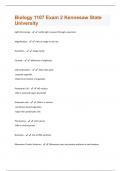
-
Biology 1107 Exam 2 Kennesaw State University Questions And Answers With Verified Solutions
- Exam (elaborations) • 16 pages • 2024
- Available in package deal
-
- $7.99
- + learn more
Light Microscope - -visible light is passed through a specimen Magnification - -ratio of image to real size Resolution - -image clarity Contrast - -difference in brightness Cell fractionation - -Takes cells apart -separate organelle -Determine function of organelles Prokaryotic Cell - -NO nucleus -DNA is unbound region (nucleoid) Eukaryotic cells - -DNA is in nucleus -membrane bound organelles -larger then prokaryotic cells The Nucleus - -Cell's genes -DNA in chromosomes Nucleolus...
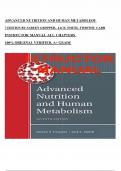
-
Instructor Manual for Advanced Nutrition and Human Metabolism 7th Edition By Sareen Gropper, Jack Smith, Timothy Carr (All Chapters, 100% Verified) A+ Grade
- Other • 160 pages • 2024
-
- $19.64
- + learn more
Instructor Manual for Advanced Nutrition and Human Metabolism 7th Edition By Sareen Gropper, Jack Smith, Timothy Carr (All Chapters, 100% Verified) A+ Grade-Table of Contents • Chapter Outline • Resources • Perspectives – Classroom Discussion • Assignment – Group Project • Answer Keys o Case Study o Responding to Research o Labeling It • Worksheet 1: Responding to Research – Mitochondria and Aging • Worksheet 2: Labeling It – A Eukaryotic Cell Chapter Outline ...
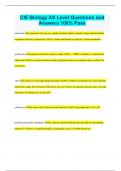
-
CIE Biology AS Level Questions and Answers 100% Pass
- Exam (elaborations) • 79 pages • 2023
- Available in package deal
-
- $12.49
- + learn more
CIE Biology AS Level Questions and Answers 100% Pass eukaryote organisms who possess nuclei; includes plants, animals, fungi and unicellular organisms known as protoctists; DNA is linear and bound to proteins to form chromatin. prokaryote organisms that lack nuclei; usually 1000 x - 10000 x smaller in volume than eukaryotes; DNA is circular and free in the cytoplasm; known as simplest cells; contain 70s ribosomes. virus consists of self-replicating molecule of DNA or RNA; has protective coat o...
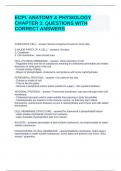
-
ECPI. ANATOMY & PHYSIOLOGY CHAPTER 3. QUESTIONS WITH CORRECT ANSWERS
- Exam (elaborations) • 10 pages • 2024
-
Available in package deal
-
- $16.49
- + learn more
ECPI. ANATOMY & PHYSIOLOGY CHAPTER 3. QUESTIONS WITH CORRECT ANSWERS COMPOSITE CELL: Shows components found in most cells. 3 MAJOR PARTS OF A CELL: 1. Nucleus 2. Cytoplasm 3. Cell membrane - outer bound area CELL (PLASMA) MEMBRANE: - Outer boundary of cell - Regulates entry and exit of substances meaning it's selectively permeable and makes decisions on what goes in the cell. - Consist mainly of lipids. - Bilayer of phospholipids, cholesterol, and proteins with some carbo...

-
Straighterline Intro to Biology 101 Chapter 3 Already Passed
- Exam (elaborations) • 13 pages • 2024
- Available in package deal
-
- $9.99
- + learn more
Straighterline Intro to Biology 101 Chapter 3 Already Passed Cell smallest unit of life Atom smallest unit of an element Molecule union of two or more atoms Tissue group of cells with a common structure and function Organ composed of tissue functioning together for a specific task Organ system composed of several organs working together Organism an individual Population organisms of the same species in a particular area Community interacting populations in a particula...

-
Chapter 12: The Cell Cycle (Mitosis) Questions and Answers Graded A+
- Exam (elaborations) • 14 pages • 2024
- Available in package deal
-
- $9.99
- + learn more
Chapter 12: The Cell Cycle (Mitosis) Questions and Answers Graded A+ What are the three key roles of cell division? State each role and give an example Reproduction: an amoeba single celled eukaryote divides into two cells. Growth+Development: fertilized egg divides into two cells, beginning embryo formation. Tissue Renewal: dividing bone marrow will give rise to new blood cells What is meant by the cell cycle? the life of a cell from the time it's first formed from a dividing parent cell unt...
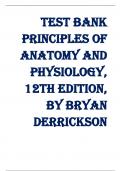
-
Test Bank Principles of Anatomy and Physiology, 12th Edition, by Bryan Derrickson, Gerald Tortora | Complete Guide A+
- Exam (elaborations) • 748 pages • 2023
-
- $17.99
- 1x sold
- + learn more
Test Bank Principles of Anatomy and Physiology, 12th Edition, by Bryan Derrickson, Gerald Tortora Testbank Chapter 1. An Introduction to the Human Body Multiple Choice 1. This is the study of the functions of body structures. a. Anatomy b. Physiology c. Dissection d. Histology e. Immunology Ans: B Difficulty: easy Feedback: 1.1 2. This is defined as a group of cells with similar structure and function. a. Tissue b. Organ c. Molecules d. Compounds e. Organism Ans: A Difficulty: easy Feedback: 1.2...
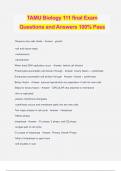
-
TAMU Biology 111 final Exam Questions and Answers 100% Pass
- Exam (elaborations) • 12 pages • 2024
- Available in package deal
-
- $12.49
- + learn more
TAMU Biology 111 final Exam Questions and Answers 100% Pass Reasons why cells divide - Answer- -growth -cell and tissue repair -maintenance -reproduction When does DNA replication occur - Answer- before cell division Prokaryotes accomplish cell division through - Answer- binary fission + cytokinesis Eukaryotes accomplish cell division through - Answer- mitosis + cytokinesis Binary fission - Answer- asexual reproduction by separation of cell into new cells Steps for binary fission - Ans...

How much did you already spend on Stuvia? Imagine there are plenty more of you out there paying for study notes, but this time YOU are the seller. Ka-ching! Discover all about earning on Stuvia


